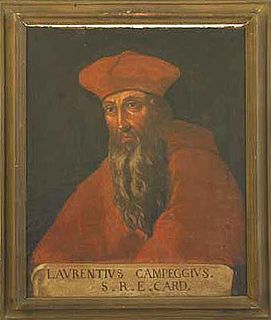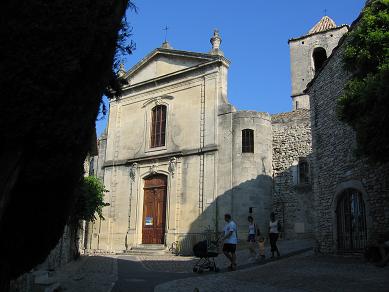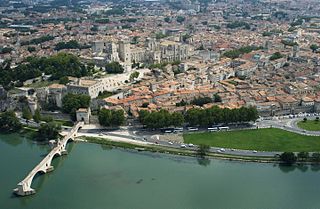
David Cardinal Beaton was Archbishop of St Andrews and the last Scottish Cardinal prior to the Reformation.

Lorenzo Campeggio (1474–1539) was an Italian cardinal and politician. He was the last cardinal protector of England.
John Scotus was a 12th-century Bishop of St. Andrews and Dunkeld.
Walter Wardlaw was a 14th-century bishop of Glasgow in Scotland.
Robert Blackadder was a medieval Scottish cleric, diplomat and politician, who was abbot of Melrose, bishop-elect of Aberdeen and bishop of Glasgow; when the last was elevated to archiepiscopal status in 1492, he became the first ever archbishop of Glasgow. Archbishop Robert Blackadder died on 28 July 1508, while en route to Jerusalem on pilgrimage.
Alexander Gordon was a 16th-century Scottish churchman who was successively archbishop of Glasgow, titular archbishop of Athens, bishop of the Isles and bishop of Galloway. His father was John Gordon, Lord Gordon and his mother was Margaret Stewart, an illegitimate daughter of James IV of Scotland. He was the brother of George Gordon, 4th Earl of Huntly, the ex-Chancellor of Scotland. He acquired his first ecclesiastic appointment, as administrator of Caithness, despite competition with Robert Stewart, brother of the Earl of Lennox. He was provided and consecrated to the archdiocese of Glasgow in the year 1550. This see was resigned to the pope in 1551, and he was given a pension and the title archbishop of Athens in partibus, along with the commendam of Inchaffray. In 1553, he was translated to the bishopric of the Isles (Sodor) at Iona. In 1559, after the death of the bishop of Galloway, Alexander was translated that bishopric. Alexander became a Protestant, and died on 11 November 1575.

The Ancient Diocese of Vaison was a Roman Catholic diocese in France, suppressed in 1801, with its territory transferred to the diocese of Avignon. It had been one of nine dioceses in the ecclesiastical province presided over by the Archbishop of Arles, but a later reorganization placed Vasio under the Archbishop of Avignon. Jurisdiction inside the diocese was shared between the Bishop and the Comte de Provence, higher justice and the castle belonging to the Comte, and civil justice and all other rights belonging to the Bishop. The Cathedral was served by a Chapter which had four dignities: the Provost (Praepositus), the Archdeacon, the Sacristan, and the Precentor. There were also six Canons, each of whom had a prebend attached to his office.
Clement was a 13th-century Dominican friar who was the first member of the Dominican Order in Britain and Ireland to become a bishop. In 1233, he was selected to lead the ailing diocese of Dunblane in Scotland, and faced a struggle to bring the bishopric of Dunblane to financial viability. This involved many negotiations with the powerful religious institutions and secular authorities which had acquired control of the revenue that would normally have been the entitlement of Clement's bishopric. The negotiations proved difficult, forcing Clement to visit the papal court in Rome. While not achieving all of his aims, Clement succeeded in saving the bishopric from relocation to Inchaffray Abbey. He also regained enough revenue to begin work on the new Dunblane Cathedral.
Donald Campbell was a 16th-century Scottish noble and churchman. He was the son of Archibald Campbell, 2nd Earl of Argyll and Elizabeth Stewart, daughter of John Stewart, 1st Earl of Lennox. From 1522, he was a student of St Salvator's College, at the University of St Andrews. After graduation, he became a cleric in his home diocese, the diocese of Argyll.
Robert Crichton was a 16th-century Scottish Catholic cleric.
William Gordon was a 16th-century Scottish noble and prelate, the last of the pre-Reformation bishops of Aberdeen owing allegiance to the Roman Catholic Church.
William Stephen, sometimes William Stephani, was a medieval prelate based in Scotland, who became Bishop of Orkney and then Bishop of Dunblane. A reader in divinity at the University of St Andrews at its first establishment, he was provided by Avignon Pope Benedict XIII as Bishop of Orkney 15 November 1415. He was a canon of Moray at this date. The consecration took place at the Papal court.

Albin was a 13th-century prelate of the Kingdom of Scotland. A university graduate, Albin is known for his ecclesiastical career in the diocese of Brechin, centred on Angus in east-central Scotland.
Laurence de Ergadia was a thirteenth-century Scottish bishop. Probably from the MacDougall kindred of Argyll, Laurence had become a Dominican friar and presumably university graduate before being elected Bishop of Argyll, an election which took place sometime between 1262 and 1264. Although the election was quashed by the Pope in 1264, the Pope gave him a fresh provision to the bishopric. Laurence appears intermittently in the records during his three and a half decade episcopate, but his activities in his own diocese are badly recorded. He died as Bishop of Argyll sometime in either 1299 or 1300.
William Cumin was a medieval Bishop of Durham elect, and Lord Chancellor of Scotland.

James Chisholm, Bishop of Dunblane, was the eldest son of Edmund Chisholm, the first Chisholm to own the estate of Cromlix in Dunblane parish, Strathearn, having moved from the Scottish Borders. In his early years as a clergyman, he was a chaplain to King James III of Scotland; the king apparently sent him to Rome for some time.
Chisholm is a Scottish surname. The original name was 'De Chesé' to which the Saxon termination 'holme' was added on the marriage of a Norman ancestor with a Saxon heiress. The first recorded person of the name is a John de Chisholme, who is named in 1254 in a bull of Pope Alexander IV and found in the County of Roxburgh The original Chisholms are said to have "came soon after the conquest, A.D. 1066 from Tindale, England. In the 14th century, members of the Chisholm family migrated into the Scottish Highlands and their name was Gaelicised. The Scottish Gaelic form of the name is Siosal (masculine), and Shiosal (feminine).
















